Poultry Vaccines Market Size
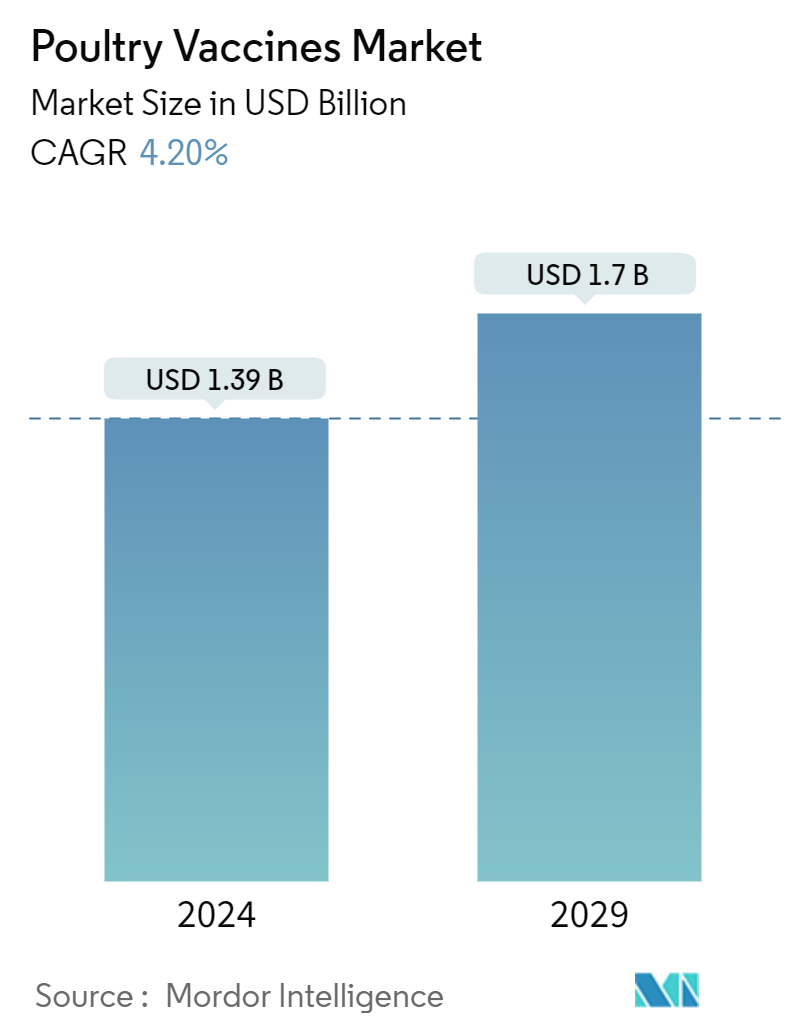
| Study Period | 2019 - 2029 |
| Market Size (2024) | USD 1.39 Billion |
| Market Size (2029) | USD 1.7 Billion |
| CAGR (2024 - 2029) | 4.20 % |
| Fastest Growing Market | Asia Pacific |
| Largest Market | North America |
Major Players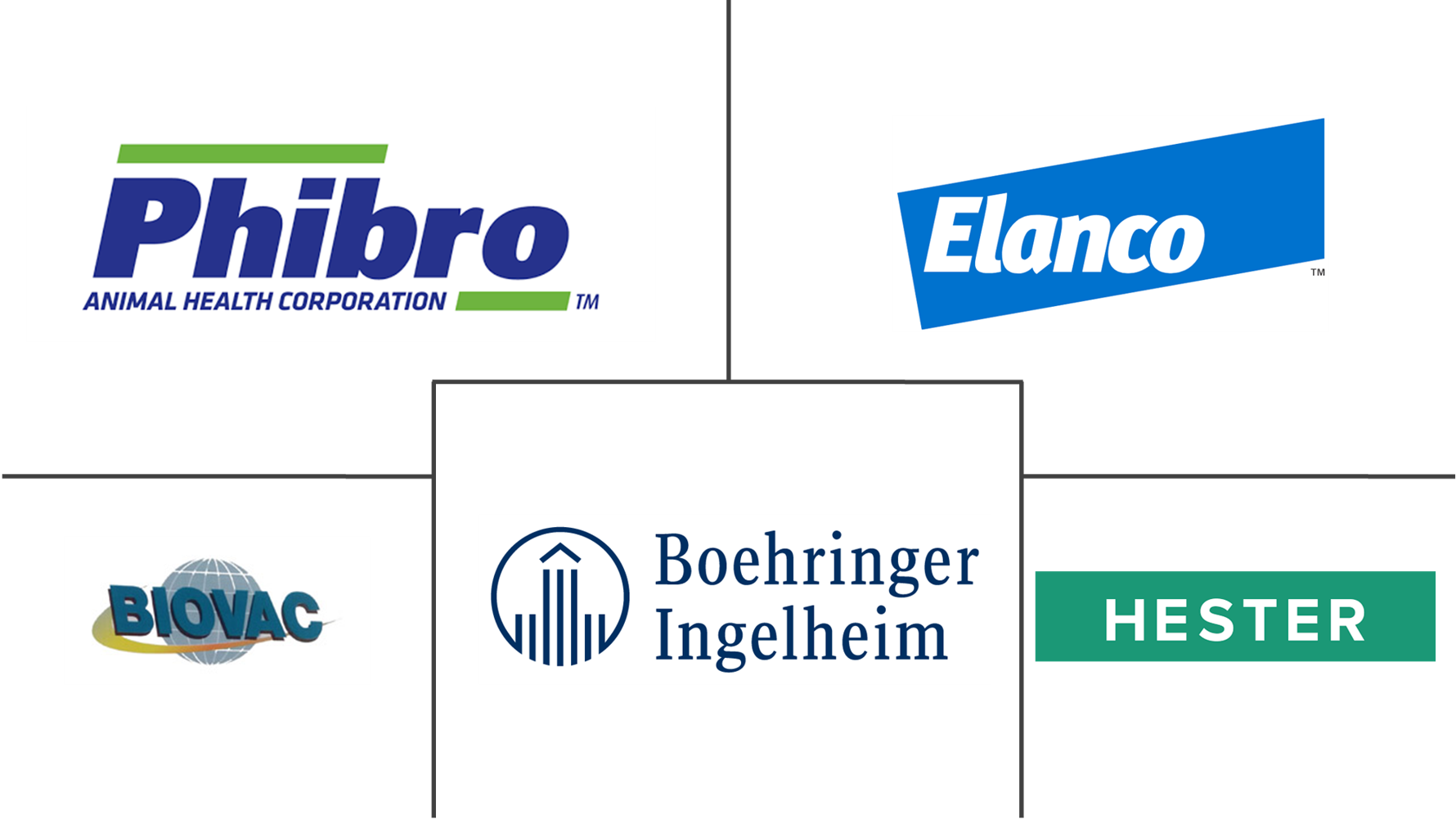
*Disclaimer: Major Players sorted in no particular order |
Poultry Vaccines Market Analysis
The Poultry Vaccines Market size is estimated at USD 1.39 billion in 2024, and is expected to reach USD 1.7 billion by 2029, growing at a CAGR of 4.20% during the forecast period (2024-2029).
Poultry farming is a vital industry in the global food sector, providing a significant source of protein. However, diseases pose a constant threat to poultry health, leading to economic losses for farmers and impacting food security. To combat this challenge, the use of vaccines in the poultry industry has become increasingly prevalent. Over the years, the poultry vaccines market has witnessed substantial growth, driven by various factors such as increasing poultry production, rising awareness about disease prevention, and advancements in vaccine technology.
One of the primary drivers behind the growth of the poultry vaccines market is the expansion of poultry production worldwide. With growing populations and rising incomes in many regions, there is a greater demand for poultry products. For instance, according to the United Nations, the global population could grow to around 8.5 billion by 2030, 9.7 billion by 2050, and 10.4 billion by 2100. Consequently, farmers are scaling up their operations to meet this demand, leading to larger poultry populations that require effective disease management strategies.
Farmers are increasingly recognizing the importance of preventive measures in maintaining the health and productivity of their poultry flocks. Vaccination is seen as a proactive approach to disease management, offering protection against a wide range of viral and bacterial pathogens. By vaccinating their birds, farmers can significantly reduce the risk of disease outbreaks, resulting in improved flock health and productivity.
Advancements in vaccine technology have also played a crucial role in driving the growth of the poultry vaccines market. Researchers and manufacturers are continually developing new and improved vaccines that offer better efficacy, safety, and convenience. This includes the development of recombinant vaccines, vector vaccines, and novel delivery systems, providing farmers with a broader range of options to protect their poultry flocks.
Thus, due to the above-mentioned factors, the market is expected to witness substantial growth during the forecast period.
Poultry Vaccines Market Trends
The Segment for Avian Influenza is Expected to Lead the Market in the Coming Years
Avian influenza, commonly known as bird flu, continues to pose a significant threat to global poultry production and public health. With outbreaks occurring periodically, the avian influenza market is witnessing a notable increase in demand for preventive and control measures. Avian influenza is transmitted to human beings by direct contact. Disease outbreaks have been reported in countries such as the United States, Asia, and Europe.
Avian influenza outbreaks have been documented across various regions, impacting both commercial and backyard poultry flocks. The highly pathogenic nature of some avian influenza strains, such as H5N1, H5N8, and H7N9, has led to substantial economic losses in the poultry industry due to mortality, trade restrictions, and control measures.
Government agencies worldwide are implementing regulations and control measures to mitigate the risk of avian influenza spread and transmission. These measures include surveillance programs, biosecurity protocols, movement restrictions, and vaccination campaigns. Compliance with these regulations is essential for maintaining poultry health and minimizing the impact of avian influenza outbreaks on public health and food security.
In March 2024, the CDC issued a set of guidelines aimed at detailing their suggestions for averting exposure to highly pathogenic avian influenza (HPAI) A (H5N1) viruses. These recommendations encompass infection prevention and control strategies such as the utilization of personal protective equipment, testing, antiviral therapy, patient inquiries, surveillance of individuals who have been in contact with potentially infected wild or domestic animals, as well as livestock, and the administration of antiviral chemoprophylaxis to those who have been exposed.
Thus, the avian influenza market is witnessing an upward trajectory fueled by increasing incidence rates, growing demand for preventive and control measures, and advancements in research and technology. As the global poultry industry continues to evolve, stakeholders must remain vigilant and proactive in implementing effective strategies to prevent and mitigate the impact of avian influenza outbreaks. Continued investment in research, innovation, and collaboration across industries will be crucial in addressing the challenges posed by avian influenza and ensuring the sustainable growth of the poultry industry.
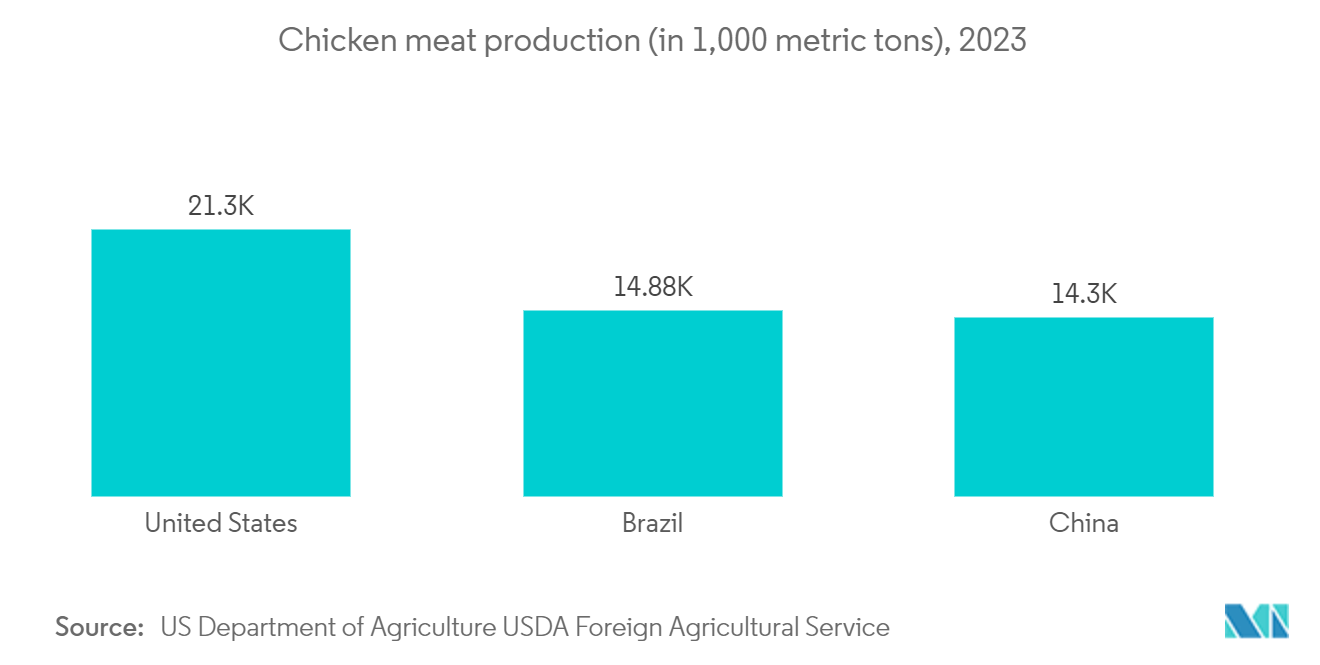
North America is Expected to Dominate the Market Over the Forecast Period
The North American poultry vaccine market is expected to hold a significant share over the forecast period, owing to factors such as the increase in consumption of poultry-derived products, growing consumer awareness regarding food safety, and increasing incidence of zoonotic diseases associated with poultry.
US poultry products hold leading positions in international and US meat commodity markets, owing to modern poultry genetics, abundant domestic feed resources, competitive production structures, and strong consumer appeal. According to the US Department of Agriculture, the total sales of the poultry sector in 2022 amounted to USD 76.9 billion, an increase of 67% from 2021. Broiler sales increased by 60%, turkey sales increased by 21%, and egg sales increased by 122%. Only broilers increased production in 2021. All the industries were affected by increased prices in 2022, with the egg and turkey industries being particularly impacted by the highly pathogenic avian influenza (HPAI) outbreak.
Increased investment in research and development activities aimed at developing poultry vaccines is driving innovation in the market. Pharmaceutical companies, biotechnology firms, and research institutions are collaborating to develop novel vaccines, diagnostics, and therapeutics to enhance the prevention and control of poultry outbreaks. For instance, In April of 2024, Merck Animal Health revealed that it had signed a deal with Cambridge Technologies, a custom vaccine company in Worthington, Minnesota, to distribute and promote its groundbreaking autogenous poultry vaccines in the American market.
In North America, advancements in vaccine development include the development of live vector vaccines, non-replicating recombinant antigen vaccines, nucleic acid-mediated vaccines, and live-gene-deleted vaccines. This is likely to fuel the market’s growth over the forecast period.
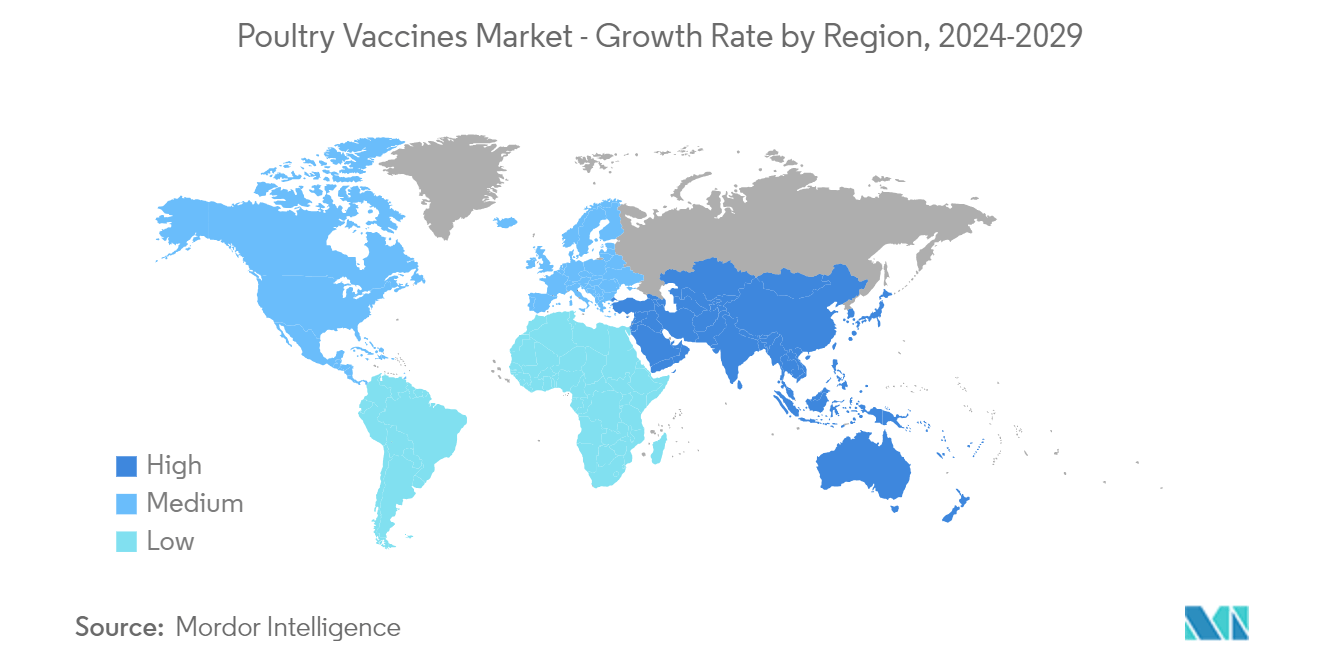
Poultry Vaccines Industry Segmentation
Players in the poultry vaccines market are involved in various growth strategies such as collaborations, partnerships, agreements, and mergers and acquisitions to enhance their market presence. A few key players in the market are Bio-Vet, Boehringer Ingelheim, Ceva Animal Health, Elanco, Merck & Co., Phibro Animal Health Corporation, Venkys, and Zoetis Inc.
Poultry Vaccines Market Leaders
-
Hester Biosciences Limited
-
Boehringer Ingelheim International GmbH
-
Phibro Animal Health Corporation
-
Biovac
-
Elanco
*Disclaimer: Major Players sorted in no particular order
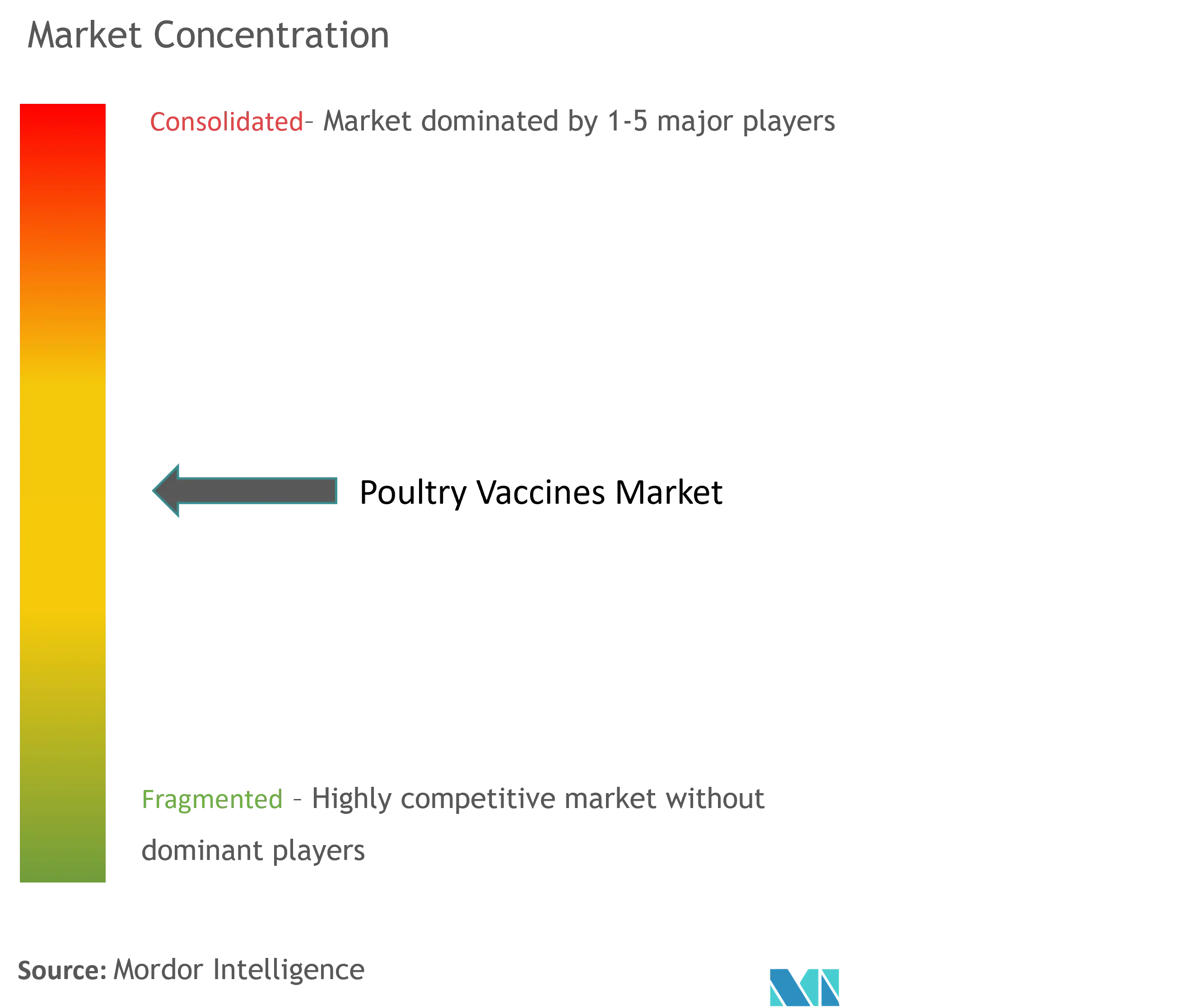
Poultry Vaccines Market News
- June 2023: MSD Animal Health, a subsidiary of Merck & Co. Inc. located in Rahway, New Jersey, announced the approval of INNOVAX-ILT-IBD by the European Commission. This HVT vaccine, which consists of two constructs, offers extended protection against infectious laryngotracheitis (ILT), infectious bursal disease (IBD), and Marek's disease (MD). As part of the centralized approval process, all European Union countries where INNOVAX-ILT-IBD was authorized revised their national registrations accordingly.
- May 2023: The US Department of Agriculture (USDA) started conducting trials to assess the effectiveness of several vaccines against the current strain of highly pathogenic avian influenza (HPAI) to contain the largest outbreak of bird flu in the nation's history. The virus was detected in all states except Hawaii, leading to almost 60 million poultry deaths.
Poultry Vaccines Market Report - Table of Contents
1. INTRODUCTION
- 1.1 Study Assumptions and Market Definition
- 1.2 Scope of the Study
2. RESEARCH METHODOLOGY
3. EXECUTIVE SUMMARY
4. MARKET DYNAMICS
- 4.1 Market Overview
-
4.2 Market Drivers
- 4.2.1 Increasing Incidences of Poultry and Zoonotic Diseases
- 4.2.2 Widened Focus on Food Safety
-
4.3 Market Restraints
- 4.3.1 Use of Counterfeit Medicine
- 4.3.2 Increasing Costs of Animal Testing and Veterinary Services
-
4.4 Porter's Five Force Analysis
- 4.4.1 Threat of New Entrants
- 4.4.2 Bargaining Power of Buyers/Consumers
- 4.4.3 Bargaining Power of Suppliers
- 4.4.4 Threat of Substitute Products
- 4.4.5 Intensity of Competitive Rivalry
5. MARKET SEGMENTATION (Market Size by Value - USD)
-
5.1 By Disease
- 5.1.1 Bronchitis
- 5.1.2 Avian Influenza
- 5.1.3 Newcastle disease
- 5.1.4 Marek's Disease
- 5.1.5 Others
-
5.2 By Technology
- 5.2.1 Recombinant Vaccines
- 5.2.2 Inactivated Vaccines
- 5.2.3 Live Attenuated Vaccines (LAV)
- 5.2.4 Others
-
5.3 Geography
- 5.3.1 North America
- 5.3.1.1 United States
- 5.3.1.2 Canada
- 5.3.1.3 Mexico
- 5.3.2 Europe
- 5.3.2.1 Germany
- 5.3.2.2 United Kingdom
- 5.3.2.3 France
- 5.3.2.4 Italy
- 5.3.2.5 Spain
- 5.3.2.6 Rest of Europe
- 5.3.3 Asia Pacific
- 5.3.3.1 China
- 5.3.3.2 Japan
- 5.3.3.3 India
- 5.3.3.4 Australia
- 5.3.3.5 South Korea
- 5.3.3.6 Rest of Asia-Pacific
- 5.3.4 Middle East and Africa
- 5.3.4.1 GCC
- 5.3.4.2 South Africa
- 5.3.4.3 Rest of Middle East and Africa
- 5.3.5 South America
- 5.3.5.1 Brazil
- 5.3.5.2 Argentina
- 5.3.5.3 Rest of South America
6. COMPETITIVE LANDSCAPE
-
6.1 Company Profiles
- 6.1.1 Biovac
- 6.1.2 Boehringer Ingelheim International GmbH
- 6.1.3 Ceva Santé Animale
- 6.1.4 Dechra Pharmaceuticals PLC
- 6.1.5 Elanco
- 6.1.6 Hester Biosciences Limited
- 6.1.7 Merck & Co. Inc.
- 6.1.8 Phibro Animal Health Corporation
- 6.1.9 Venky's Limited
- 6.1.10 Zoetis Inc.
- *List Not Exhaustive
7. MARKET OPPORTUNITIES AND FUTURE TRENDS
** Subject To AvailablityPoultry Vaccines Industry Segmentation
Vaccines help prevent diseases by boosting the immune system to produce antibodies, which, in turn, fight against organisms such as Salmonella, E. coli, and Mycoplasma gallisepticum (MG). Vaccines offer protection from diseases like Marek's disease, infectious bronchitis (IB), avian rhinotracheitis (ART), Newcastle disease, and infectious bursal disease (Gumboro disease).
The poultry vaccines market is segmented by diseases (bronchitis, avian influenza, Newcastle Disease, Marek's disease, and others), technology (recombinant vaccines, inactivated vaccines, live attenuated vaccines (LAV), and others), and geography (North America, Europe, Asia-Pacific, the Middle East and Africa, and South America). The report offers the value (in USD) for the above segments.
| By Disease | Bronchitis | |
| Avian Influenza | ||
| Newcastle disease | ||
| Marek's Disease | ||
| Others | ||
| By Technology | Recombinant Vaccines | |
| Inactivated Vaccines | ||
| Live Attenuated Vaccines (LAV) | ||
| Others | ||
| Geography | North America | United States |
| Canada | ||
| Mexico | ||
| Geography | Europe | Germany |
| United Kingdom | ||
| France | ||
| Italy | ||
| Spain | ||
| Rest of Europe | ||
| Geography | Asia Pacific | China |
| Japan | ||
| India | ||
| Australia | ||
| South Korea | ||
| Rest of Asia-Pacific | ||
| Geography | Middle East and Africa | GCC |
| South Africa | ||
| Rest of Middle East and Africa | ||
| Geography | South America | Brazil |
| Argentina | ||
| Rest of South America |
Poultry Vaccines Market Research FAQs
How big is the Poultry Vaccines Market?
The Poultry Vaccines Market size is expected to reach USD 1.39 billion in 2024 and grow at a CAGR of 4.20% to reach USD 1.7 billion by 2029.
What is the current Poultry Vaccines Market size?
In 2024, the Poultry Vaccines Market size is expected to reach USD 1.39 billion.
Who are the key players in Poultry Vaccines Market?
Hester Biosciences Limited, Boehringer Ingelheim International GmbH, Phibro Animal Health Corporation, Biovac and Elanco are the major companies operating in the Poultry Vaccines Market.
Which is the fastest growing region in Poultry Vaccines Market?
Asia Pacific is estimated to grow at the highest CAGR over the forecast period (2024-2029).
Which region has the biggest share in Poultry Vaccines Market?
In 2024, the North America accounts for the largest market share in Poultry Vaccines Market.
What years does this Poultry Vaccines Market cover, and what was the market size in 2023?
In 2023, the Poultry Vaccines Market size was estimated at USD 1.33 billion. The report covers the Poultry Vaccines Market historical market size for years: 2019, 2020, 2021, 2022 and 2023. The report also forecasts the Poultry Vaccines Market size for years: 2024, 2025, 2026, 2027, 2028 and 2029.
Poultry Vaccine Industry Report
The Poultry Vaccines Market Report offers a comprehensive market forecast and market size analysis, segmented by diseases such as bronchitis, avian influenza, Newcastle disease, Marek's disease, and others. The report also delves into the technology used, including recombinant vaccines, inactivated vaccines, live attenuated vaccines (LAV), and others. Geographically, the market is segmented into North America, Europe, Asia-Pacific, the Middle East and Africa, and South America.
This market forecast provides valuable insights into market trends and market share, offering a detailed market outlook. The industry analysis includes an industry overview and industry report, presenting a thorough market analysis and market growth potential. Key market leaders are highlighted, and the report serves as a crucial market research tool.
The industry analysis includes a detailed industry outlook, industry reports, and industry research, offering insights into industry sales, industry size, industry statistics, and industry trends. The report also includes market data, market growth projections, and market predictions, providing a comprehensive market review and market segmentation analysis.
For those seeking more detailed information, the report is available as a free report PDF download, providing a report example and further research from leading companies. The report's market value and market segmentation insights are crucial for understanding the market dynamics and planning strategic initiatives.
Overall, the Poultry Vaccines Market Report is an essential resource for understanding the market's current state and future potential, offering valuable industry information and industry research to stakeholders and decision-makers.



